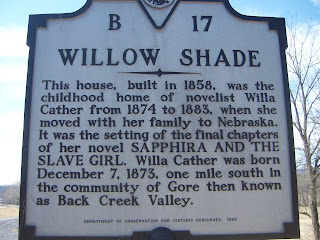 |
| Great American author, Willa Cather |
“The great disadvantage about writing of the places you love
is that you lose your beloved places forever – that is, if you are a quiet
person who doesn’t like publicity.” She wrote this in a letter to woman named
Miss Masterton, who had written Cather a ‘fan letter’ praising the latest novel
about a jealous landowner named Sapphira and a beautiful slave girl named
Nancy. (This quiet and very private person’s letters have been
published expressly against her wishes in a book called “The Selected Letters
of Willa Cather.” The editors state that
the “statute of limitations” has expired and that she is now part of our
cultural history.) Cather continues in
the same letter:
“I have not been back to Virginia since Sapphira was published . . . Such simple, honest, earnest people
live there. It would have been the same
forever if motor cars had never been invented . . . It was the most beautiful
piece of country road that I have ever found anywhere in the world. I never found anything in the Swiss or Italian
Alps so beautiful as that road once was.”
Apparently, Miss Masterton had taken a visit to Virginia to
trace the steps outlined in the novel.
“I seem fated to send people on journeys,” she remarks to Miss
Masterton, and then proceeds to tell her about other readers who have similarly
gone “a-journeying” to such places as Quebec and New Mexico, based on her
books. She tells her that the slave
girl, Nancy, is a real person, and that the story is based on an event that
actually happened. “She was exactly like
that, and old Till was just like that. I
was between five and six years old . . . “ – but Cather seems apologetic in the
letter when she refers to the house called “Willow Shade” where she lived from
ages 2 to 9:
 |
| Cather's home from ages 2 to 9 |
“I am sorry you saw that desolate ruin which forty years ago
was such a beautiful place, with its six great willow trees, beautiful lawn,
and the full running creek with its rustic bridge. It was turned into a tenement house long
since, and five years ago the very sight of it made me shiver. Of course, it still lives in my mind, just as
that March day when Nancy came back still lives in my mind.”
Cather would perhaps be happy to know that Willow Shade, 70
years hence, is privately owned by a non-Cather family who reside there and
have restored it to historic standards – (though she was not to know that the house
served as a hospital for a short while after it was a tenement house).
 |
| Willa Cather's birth home today |
The decrepit condition of her birth home would undoubtedly
cause Willa Cather to shiver profusely. She
most likely stayed in this home whenever she came to visit Virginia, for it was
owned at the time by Cather relatives.
In this home, in the years preceding the writing of Sapphira, I imagine she acquired both the inspiration and material for
her final novel. She made no comment
about this house in any of her letters that I have read so far, most probably
because it was well tended at the time and she had no concern or need to make
comment.
The home today is taken over by termites and neglect. Once lived in by Cather relatives, the home
has been abandoned for decades and is for sale by the current owner who would love
to see it preserved but does not have the resources or ability to do so
himself. Unfortunately, neither the State
of Virginia nor the literary scholars of our nation, nor the Willa Cather
Foundation of Red Cloud, Nebraska has shown any interest in preserving this historic
landmark – though a very nice sign in the front yard proclaims it a noteworthy
spot. And so, I stop by the house each spring
to linger and wonder, take a few pictures of the changes I see, and then leave.
While scholars busy themselves to publish private letters
that the author had expressly stated should never be published, the author’s own birth home – located near “the most beautiful piece of country road . . . in the world,” amongst a people
she said were the most honest and earnest
– is sadly given over to termites and the next big storm that deems to take
it down. We should all shiver to know
this.
 |
| I imagine Willa Cather taking her first steps here |
 |
| Did she gaze out this window while imagining Sapphira? |



